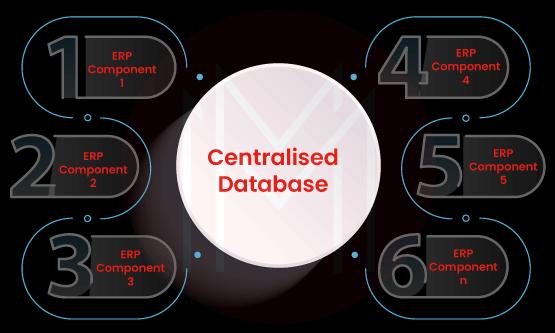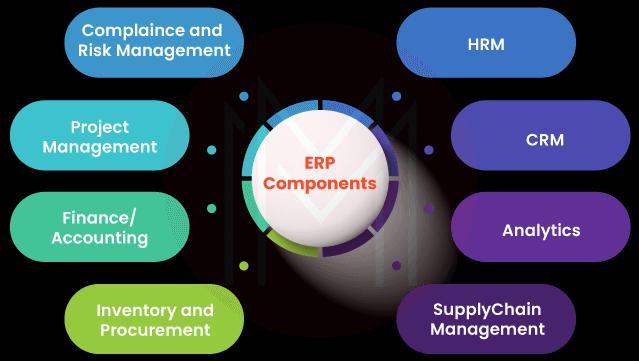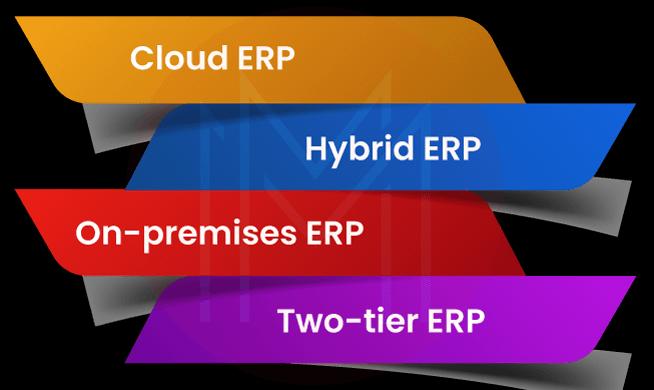It is a simple but essential note that every business runs with many complex and evolving business processes. No single organization can be exempted from this real-time business scenario. Only businesses that quickly adapt to the changing demands can keep pace with their competitors or survive in the market at the least. So, it is necessary to pick the right tool to manage complex business processes and optimize workflows. This way, ERP is one of the software widely used across many organizations to streamline business processes, boost productivity, and gain profits.
ERP refers to Enterprise Resource Planning. ERP is the software that connects all the business processes, ensures seamless data transfer between the processes, and improves operational efficiency. Simply put, it a software that offers an integrated platform to optimize the day-to-day business processes of any organization. Here, the business processes may be accounting and finance, project management, material procurement, logistics, risk management, and compliance, human resource management, supply chain management, and many more. Overall, ERP ensures resilience and agility in business processes, which tends organizations to grow rapidly.
This blog delves into ERP, ERP components, various deployment modes, and its uses and limitations in greater detail.
ERP Components - Table of Content
What is an ERP System?
Know that data is the backbone of any business. That’s why we collect, analyze, organize, and distribute data to use it efficiently. The main thing about an ERP system is that it collects all the business data in one place and creates a central hub. This is where various departments of a business can access data seamlessly. At the same time, ERP systems ensure data integrity and offer data security as well.
Know that ERP systems can be deployed in the cloud and on-premises. With an ERP system, you can manage all your business processes, from material procurement to production to product delivery, in a single place. Also, ERP systems allow for achieving complete transparency across business processes. As a result, people and systems can hit their best with the correct data.
| Want to Become a Master in Netsuite? Then visit here to Learn Netsuite Online Training Course! |
How does ERP Work?
An ERP system comes with a shared or central database and different ERP components based on the needs of various departments of an organization. You can store all the business data and transactions in the database. The database functions as the ‘single source of truth and provides accurate and up-to-date information to the ERP components. So, the ERP components in an ERP system can easily communicate with others and share information. Mainly, the information updated in an ERP component will be automatically updated in the central database. This updated data will be immediately available to all other ERP components.

Know that ERP systems process all the data in real time. So, you can quickly identify and rectify issues in business processes and resolve them as quickly as possible. In other words, ERP systems allow business executives to get up-to-date information on business processes through a single channel and take appropriate decisions dynamically. In short, ERP systems ensure consistency across all business processes by sharing updated data with all the ERP components.
| Related Article: Types of ERP |
Why ERP?
Are you wondering why ERP plays a vital role in optimizing business processes? Here are the reasons for the same.
- ERP overcomes data duplication since it collects data from many sources and organizes them, eliminating the double-entry of data.
- ERP can manage any business – no matter the size and type of the business
- An ERP system acts as a centralized system that unites all business processes in a single point and improves the collaboration among the processes.
- ERP systems can monitor inventory levels closely and allow people to make resource management and better production planning. Thus, it enhances productivity and increases profits.
- ERP systems provide an all-in-one dashboard where you can view advanced analytics and valuable insights. With these analytics and insights, you can grasp the status of business processes in a single view and then make decisions to
- Improve the processes and boost productivity significantly. No surprise, ERP systems allow customizing dashboards per users' needs.
- ERP CRM component helps improve customer relationships and satisfaction to greater levels.
- Undeniably, compliance and risk management are vital components of any business. No doubt you need to monitor the compliance requirements closely. Otherwise, any slight deviation in the requirements would lead to severe disasters.
- ERP systems support businesses to meet compliance requirements and manage risk management accurately.
What are the Different ERP Components?
This section discusses all the ERP components that you need to know. Let’s see them one by one below.
Human Resource Management – HRM: This ERP component helps HR teams keep track of employees' records. The records may include employee information such as contact information, performance review results, compensation, grants, and rewards. With this ERP component, you can track key workforce management metrics such as retention rate, average pay, promotion rate, etc.
Moreover, using this ERP component, you can simplify various HR operations such as employee payments, generating performance reports, tax payments, managing promotions, monitoring attendance, and many more. Mainly, you can perform payroll calculations down to the level of hours. This ERP component can automate making payments to employees’ bank accounts and managing compensation forms. This ERP HRM component allows for managing employees’ recruitment and performance smoothly. Not just that, it supports managing employees’ onboarding as well as off-boarding. An ERP system helps allocate employees for different roles and responsibilities regarding performance management.
Customer Relationship Management - CRM: Know that CRM is essential to any business. With the ERP CRM component, you can easily manage leads, track all customer communications, and enhance customer service and satisfaction. This ERP component helps you to understand customers’ product expectations and collect their feedback for further analysis. And it provides valuable insights that you can use to boost sales and marketing to higher levels. The customer data analysis done by this component allows for knowing customers' buying behaviors and increases the conversion rate. Not just that, this ERP component can be easily connected with customers’ payment history, which will be helpful for businesses in many ways.
Analytics: This ERP component identifies the key drivers that can gear up the profits of a business. For example, you can optimize the working capital and control unnecessary expenditures. You can put together all the financial analyses of different business departments in one place and view them all – at a glance. This ERP component allows customizing analytics visuals per business users' needs. The underlying AI capabilities of this ERP component help to make quick predictions on various business dependencies.
Supply Chain Management - SCM: This ERP component helps to plan order fulfillment, logistics, procurement, production, sales and operations, and many more. And it allows for quickly responding to changing demands in supply and market conditions. Simply put, you can enhance supply chain collaboration and attain a resilient supply chain. This ERP component helps to manage warehouses and track inventory levels and transportation. When the business operations are too complex, you can use specific ERP components such as Transportation Management System (TMS) and Warehouse Management System (WMS) to optimize supply chain management.
Inventory and Procurement: With the inventory ERP component, you can optimize materials management at a global level. This ERP component streamlines working capital and inventory levels and helps to get complete visibility across product flow. As a result, you can optimize material and supply chain management, control inventory movements, reduce costs, and achieve enhanced customer satisfaction.
Regarding material procurement, this ERP component simplifies strategic sourcing, purchasing, supplier relationship management, payments, etc. It allows for reducing risks and improving savings. As a whole, you can quickly improve productivity and profits.

Finance/Accounting: This ERP component allows you to increase the precision of financial forecasting and minimize the reporting cycles with the help of organized financial data. You can connect all your financial processes and automate them, which will help monitor organizations' financial health. Not only that, this ERP component supports managing accounting, payables and assets, analytics, revenue management, collections, receivables, expenses management, and many more. On top of all, this ERP component simplifies decision-making and manages risks and compliances effectively.
Project Management: This is yet another ERP component with which you can create project plans for critical projects in a single point. You can allocate the correct resources to the correct people at the right time and manage them effectively. This ERP component allows sharing of goals and project schedules across your team and stakeholders. By using the existing data, you can quickly generate accurate budgets. Not just that, this component helps forecast the project plans as well as resource plans from the current data. Even it allows using voice and text commands to perform routine tasks from smartphones. What’s more! Using this ERP component, you can manage costs, project assets, billing and revenue, and many more.
Risk Management and Compliance: Using this ERP component, you can build resilience in business processes by adapting to constant and continuous changes. Here, the changes may occur because of many internal and external factors. So, this ERP component supports tracking user activity, controlling user access, and meeting compliance regulations and requirements. This ERP component supports building security rules for various roles and business processes. For example, you can generate Separation of Duties (SoD) confidently. Besides, this component helps to protect sensitive data from third parties when you leverage it in your system.
| Related Article: NetSuite ERP Interview Questions For Beginners |
How to Deploy ERP in Different Modes?
Are you interested in knowing the different ERP deployment modes? No worries! Next, we will look at how to deploy ERP components in multiple ways.
Cloud ERP: It is also known as SaaS ERP. The ERP software may use the public or private cloud in this deployment mode. With the cloud ERP, you can immediately start to use the required software, hardware, and other resources. It means you can quickly implement cloud ERP in your systems and use it as soon as possible. In addition to that, ERP systems can scale automatically based on the changing demands. The essential advantage the cloud ERP is that ERP software providers will take care of the software installation, upgrades, maintenance, software updates, support, etc. Hence, organizations can use their own resources for business development instead of managing the IT infrastructure.
On-premises ERP: ERP software is usually installed in organizations' data centers in this deployment mode. Organizations that use controlled systems and sensitive data can choose on-premises ERP systems. At the same time, it demands organizations perform installation and maintenance by themselves – not by ERP software providers. However, this mode offers good flexibility for customization.
Hybrid ERP: This deployment mode includes the combination of the cloud and on-premises methods. It doesn’t matter whether you want cloud or on-premises deployment, Hybrid ERP provides the flexibility to choose the correct method based on your needs. In other words, you can decide which systems and data should be moved to the cloud and which ones to use on-premise resources. For example, if you want to manage controlled data, then you can move this data to the cloud and others to on-premise resources. As a result, hybrid ERP effectively manages workloads and reduces delays and risks. In a way, the hybrid deployment mode is the stepping stone for organizations' digital transformation.
Two-tier ERP: This deployment mode includes two tiers of ERP implementation. One tier is the centralized ERP system that will manage the main facilities of an organization. Another tier is the satellite ERP system that manages the remote facilities of the organization. Though the initial cost is lower in this method, the costs will rise at later stages, inevitably.

What are the Uses of ERP?
There are a lot of benefits while using ERP software and ERP components. Here, we will unpack the key benefits of ERP as follows:
- ERP is an integrated platform with which you can simplify managing business processes and increase user experience
- ERP systems provide consistent infrastructure across the different sections of a business and enhance collaboration among all the stakeholders.
- ERP provides advanced analytics and valuable insights about business processes from the real-time information
- It reduces business risks by ensuring data security and integrity
- You can implement best practices across all business processes. In return, it increases productivity and reduces operational costs.
| Related Article: Advanced Microsoft Dynamics Interview Questions |
What are the Limitations of ERP Systems?
No doubt there are a few drawbacks to ERP systems. Let’s take a look at them below:
- You will need to integrate third-party add-ins at times.
- The cost of implementation and maintenance is high.
- You need to train employees to use ERP systems efficiently – no doubt it increases operational costs.
- Poor data conversion sometimes leads to errors and causes time and cost losses.
Conclusion:
Long story short – we can optimize business processes, enhances collaboration, improve productivity, and increase profits by leveraging ERP. Simply put, ERP is the platform that simplifies complex business processes and supports business growth. No wonder any business can benefit by embracing the suitable ERP in its components. The biggest strength of ERP systems is that it provides a centralized database. This is where all the ERP components share their data, and all other components can access this data. Above all, the AI capabilities of ERP systems to generate analytics and insights help to make accurate and better decisions.
 On-Job Support Service
On-Job Support Service
Online Work Support for your on-job roles.

Our work-support plans provide precise options as per your project tasks. Whether you are a newbie or an experienced professional seeking assistance in completing project tasks, we are here with the following plans to meet your custom needs:
- Pay Per Hour
- Pay Per Week
- Monthly
| Name | Dates | |
|---|---|---|
| NetSuite Training | Dec 30 to Jan 14 | View Details |
| NetSuite Training | Jan 03 to Jan 18 | View Details |
| NetSuite Training | Jan 06 to Jan 21 | View Details |
| NetSuite Training | Jan 10 to Jan 25 | View Details |

















